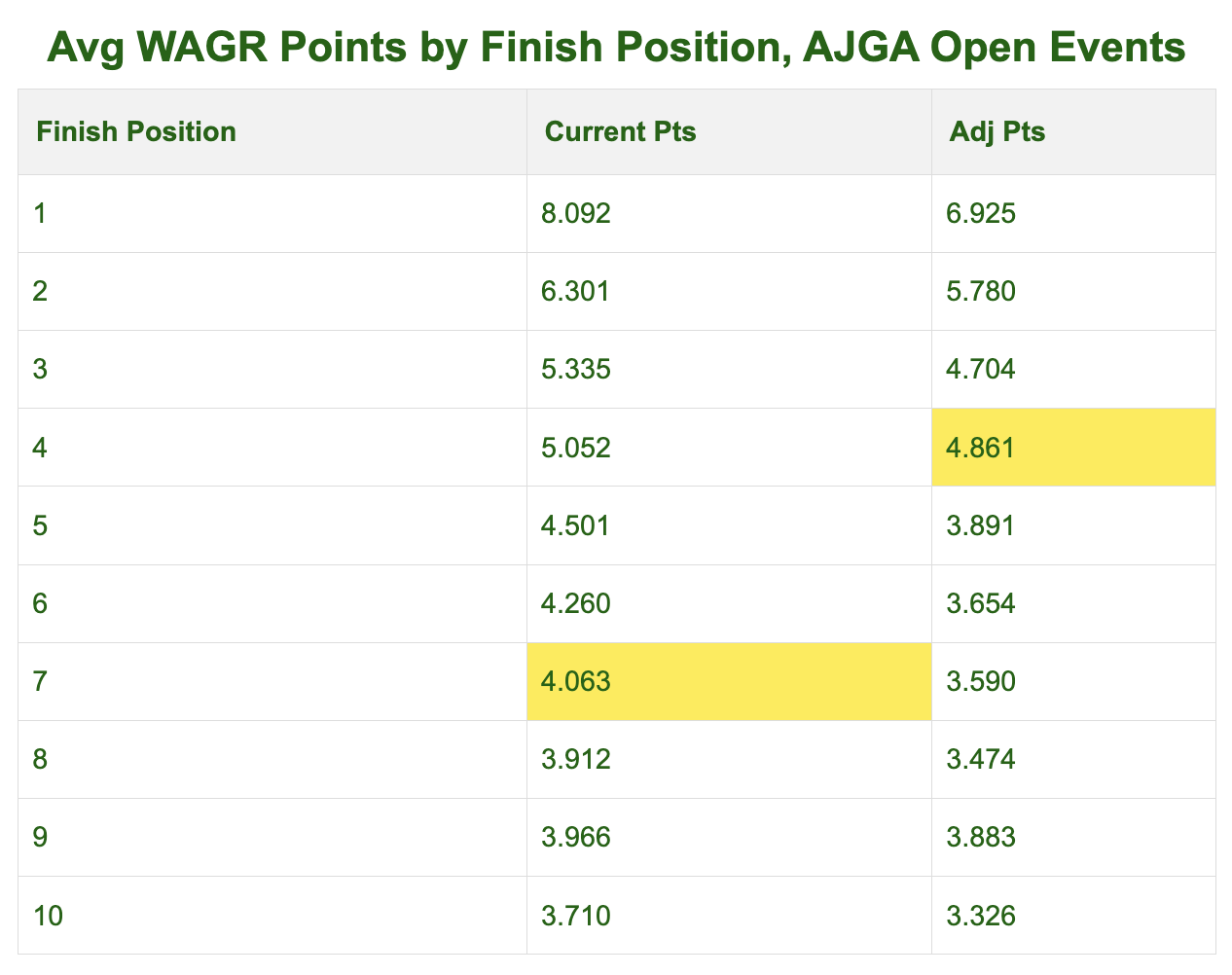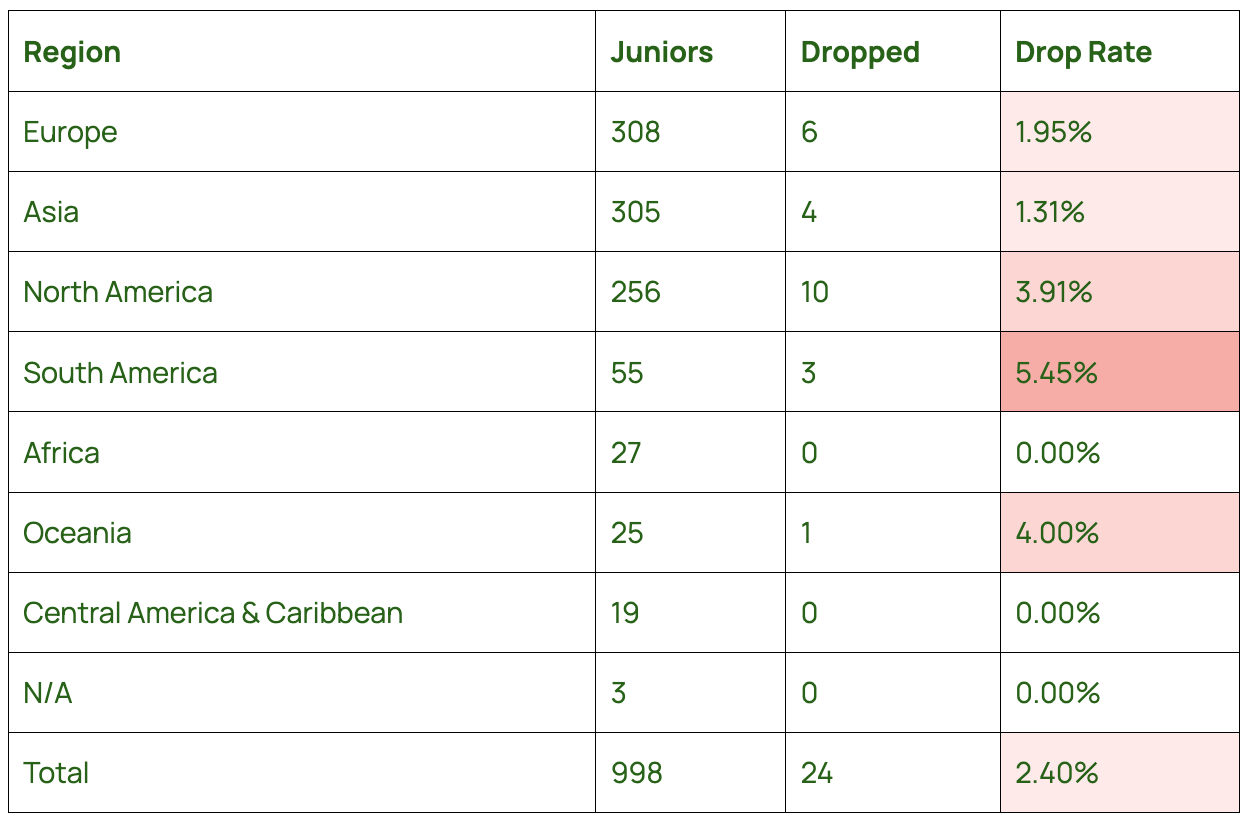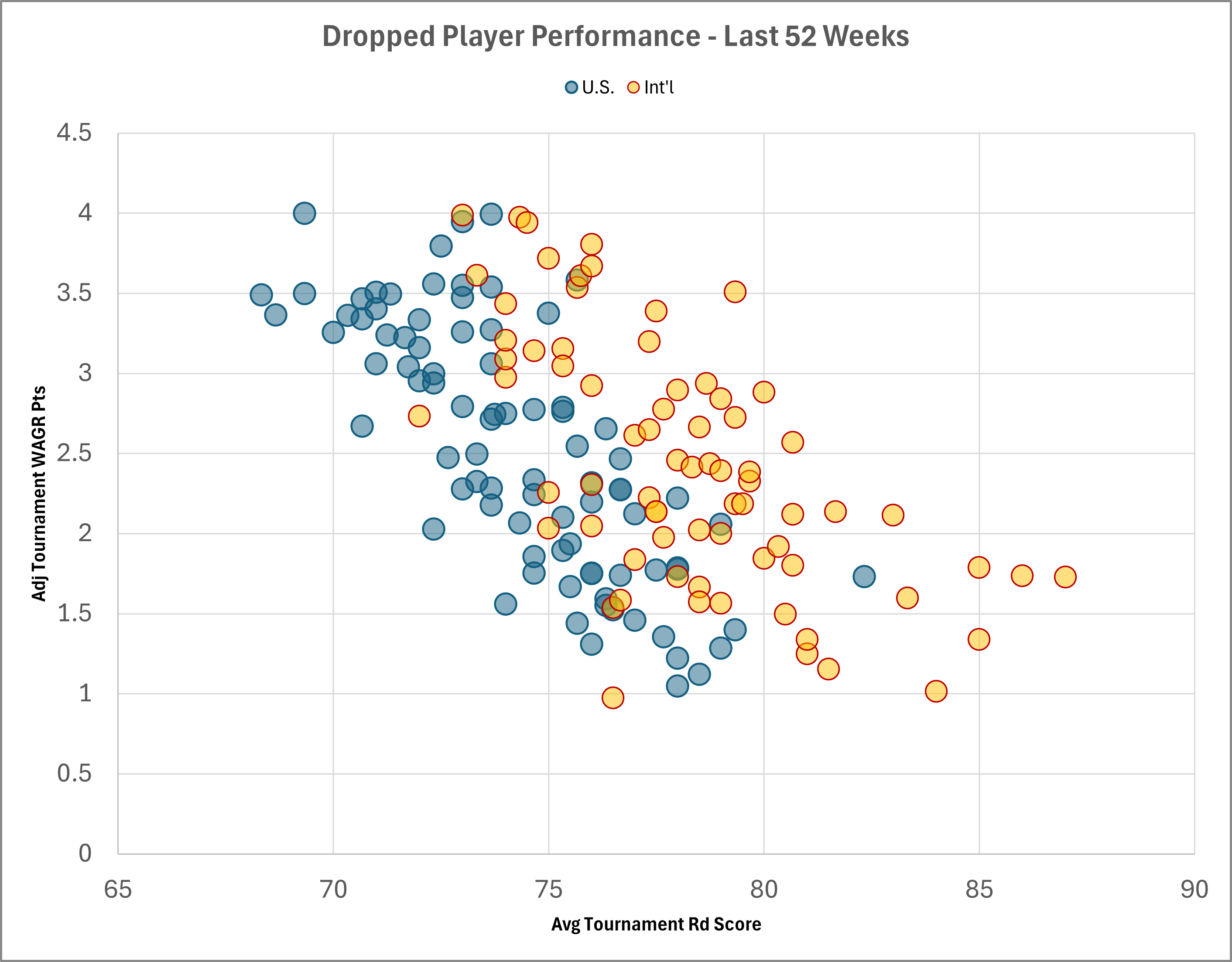
In Part I, we showed how the announced changes to the WAGR system would impact junior golfers (particularly in the U.S.) from being ranked. As you'll recall, we found 6 of the ~200 U.S. junior boys on WAGR would've never gotten ranked (i.e. never reached the 6.5 points needed to be ranked) if the "up to a 1/3rd" downward adjustment had been in place retrospectively.
Part II will look at the other way golfers can get dropped from WAGR. Below is an excerpt from the WAGR FAQs:
How does a Ranked Player remain ranked?
In order to remain a WAGR Ranked Player, a player must earn at least 4 ranking points in an event in the most recent 52-week period. If a player has been removed from the ranking, the player must once again take steps to become ranked before WAGR points can be earned again
This four-point threshold is not so easy to maintain, particularly on the boys side in the U.S. For context, the average 7th place finish in an AJGA Open event earned 4.063 pts in 2024. The seemingly arbitrary threshold is the reason why Trevor Gutschewski had a curiously-low 3570 WAGR entering the U.S. Junior. It's also the reason why juniors like Smith Summerlin and Jack Roberts -- both top 60 golfers on JGS, both winners of big-time junior events and both Auburn commits -- have dropped off of WAGR altogether. Remember, it's exceedingly difficult to become a ranked player in the U.S. It's just as tough to get ranked again.
It's worth reiterating that these players getting dropped or being under-ranked is not just unfortunate for them. It impacts the power rating for every tournament that they play in and therefore the points assigned to every golfer in those field. In truth, these are golfers who would likely be ranked in the 1000-2000 range, contributing up to 3-6 points to a given tournament's Power each, but instead they are treated as replacement-level players (no different than someone who can't break 80) who are at best a rounding error to the Power Rating.
So if it's difficult to be ranked and stay ranked as a male junior golfer in the U.S. under the current rules, how does that change starting in 2025 with the announced changes? Well, the adjusted points just made it harder to stay ranked.
It's obvious that if points are being adjusted downward by up to a third, today's 4+ point performance might be tomorrow's <4 point performance. The 7th place bar for AJGA events needed to stay ranked just got higher -- starting in 2025 you'll likely need a top 4 or top 5 finish to stay ranked.

By definition, there has to be golfers on the current WAGR that would no longer be ranked under the new regime. Anybody who plays in a sub-50 power event will receive a lower amount of points for their performance than they did before. Sub-50 events make the majority of amateur events around the world, but are most common in Junior, Mid-Am and Senior events. These players are most at risk of dropping off at a higher rate under the new rules.

We looked at all 998 junior golfers around the globe to determine how their ranking and status would change as a result of the points adjustment. If you assume these changes had been put in place two years ago (instead of January 2025), there would be 24 golfers who would drop out of the rankings by not reaching 4 points in a 52-week period. Combine this with 18 total junior golfers who never would've been ranked in the first place and about 4% of junior golfers would be wiped out under the new rules.
This may seem like a relatively small number, but the question we need to ask ourselves is this: if WAGR's goal is to be ultimate, accurate ranking system of amateur golf, are the Power ratings and rankings more accurate with these golfers included as ranked golfers or as unranked golfers?
Also, we see that there is a disparate impact across global regions and countries:


You see that the U.S. has a higher drop rate amongst its junior golfers. The bar is simply higher to get 4 points, meaning it's more likely that a U.S.-based golfer doesn't get a 4-point performance over the course of a year. Combined with the 6 U.S. golfers who would've never been ranked, the changes would wipe out 8% of the ranked population of American golfers.
The next question worth asking: are there differences in scores between those U.S. golfers getting dropped versus the Int'l juniors getting dropped? Are U.S. golfers shooting scores that would likely lead to higher finishes and staying ranked in International events? So let's look at the plot of tournament scores to adjusted WAGR Points between the 10 U.S. drops and the 14 International drops.

The scoring average of the U.S. Drops over the last year was 74.2. The scoring average of the International Drops over the last year was 78.0. It's clear that the U.S. golfers that were dropped did demonstrate the ability to shoot competitive scores. The top 25th percentile score for the U.S. group was 71. The 25th percentile for the Int'l group was 75. Unless you argue that golf courses are significantly easier in the U.S., the players are being evaluated on a different scale.
Unfortunately, it does not appear that the 2025 changes address the largest issue: that the WAGR Power Rating does not accurately reflect the strength of the field, mainly because it treats all unranked players the same. The issue is just more prevalent in the U.S. on the boys side. There should be more ranked players in the U.S. These changes will lead to less. The U.S. boys that are ranked should be ranked higher than they are currently. These changes will lead to them be ranked lower. Junior events in the U.S. should have higher Power Ratings. It appears these changes will cause the Power rating for junior events in the U.S. to drift lower over time.
Back in February, we did a WAGR comparison on Twitter of a group of 47 International juniors ranked 396-737 on WAGR at the time (all within the top 100 for a U.S. Junior exemption) and 40 U.S.-based juniors ranked 833-2388 on WAGR at the time (all outside the top 100 for a U.S. Junior exemption and all ranked worse than every golfer on the International list). The comparison showed something very similar to the plots above: U.S. kids being scored on a different standard, mostly because the Power Rating didn't reflect the true depth and strength of the field.

The proposed changes only close the International vs. U.S. gap slightly. Even after the changes, the average score on the International side doesn't dip below the 4-point Mendoza line until you reach tournament rounds in the 78+ range. For the U.S. golfers, that dip below 4-points starts at 72-72.75 and occurs a stroke earlier than it did before.

You know something is off when average tournament performances in the U.S. still score less than bottom quartile International performances almost five strokes higher. When sitting in the 72-73 range is only earning 3.77 points per event, it should be no surprise that U.S. golfers are going to be dropping off the rankings at a higher rate.

WAGR's Fundamental Flaw
There is a fundamental flaw in the proposed WAGR change. They are admitting that the current rankings are not accurate due to outliers who have benefitted from winning small, weak field events. So the change is going after those events by adjusting the points assigned to these and all other events below 50 Power rating. However, the Power Rating of the next event, and therefore the size of the adjustment, is directly tied to the current ranking of the players in the field. What you'll see is the events and players that need the biggest adjustment with only get a small adjustment, if at all, because their contribution to the tournament's Power Rating is artificially high.
To illustrate, take Jordan, one of the countries potentially most impacted by the changes. They have three juniors ranked 322nd, 340th and 526th in the most recent WAGR (Week 45), all well within the top 100 juniors in the world. When we apply the proposed changes to these players retrospectively, their WAGR points decrease by approximately 16% and their ranks drop to 1043, 891 and 1245, respectively. However, these changes are being applied on January 1st 2025 going forward and these players carry these artificially high WAGR ranks into their next tournament. Just having two of those players in a 16-man tournament with no other ranked players in the field is worth over 49 points, and thus a minimal adjustment. If you used their retrospective-adjusted WAGR's, that same event would only be worth 25.7 points.
Before We Go: A Proposed Solution
The real key here is coming with an accurate strength of field measure. And it appears the only way to achieve that is to divorce it as much as possible from the current WAGR rank. Also, it is absolutely critical that any change must differentiate unranked golfers. I propose the following:
- Rank players for strength of field purposes once they have played in four WAGR events, whether they are ranked players or not. This would be a ghost rating only for Power Rating purposes and be separate from the published WAGR ranking. We have to keep reminding ourselves that the R&A and USGA have ALL of the tournament information necessary to calculate this accurately, but they choose to ignore probably more than 80% of tournament scores knowingly and willingly.
- Convert the Ghost Rankings into a percentile of the total population and base the Power Ranking on the percentile mix of the field. This would lead to more stable power rankings over time and also eliminate any inherent differences between men's and women's events (which we'll cover at length in Part IV)
- The erosion curve for weighting the Xth best golfer in the field needs to be extended so deeper fields add a greater amount of the tournament's strength of schedule. And logically, it doesn't make sense to include the winner's WAGR ranking in the Power formula. Essentially, the golfer gets credit for beating himself.
The ghost ranking would be able to differentiate a previously ranked, now unranked player like Smith Summerlin from a 90-shooting player who has never finished in the top 80% of a tournament. And we haven't yet mentioned players who have only recently-been ranked. The ghost ranking would be able to capture their performance leading up to the time they became ranked. My favorite example is Hamilton Coleman, the 20th ranked golfer on Junior Golf Scoreboard, who was unranked until he won the Junior Players Championship over Labor Day. Despite playing in at least 9 WAGR events in the last year, his WAGR rating (4205) and contribution to the Power Rating (1.42) is based on only one event, watered down by the minimum divisor of 8. Wouldn't WAGR be more accurate if it considered his previous performances, likely leading to a Ghost Rating of around 600 and Power cotribution of 10? Under the current methodology, Coleman's contribution to the Power ranking will be undervalued until his WAGR ranking is "fully-baked", likely sometime next June. It really doesn't need to be this way.

It's worth noting that the average Divisor of U.S. junior golfers is significantly less than Int'l golfers (8.7 vs. 12.4) with a significantly higher percentage of golfers with less than the 8-event fully baked ranking (52.5% vs. 37.7%). Both of these metrics support that it's artificially difficult to become a ranked golfer and stay one as a male junior in the U.S. These proposed changes for 2025 appear to only make things worse.
To be continued...
Part III: The Impact to US Junior Exemptions
Part IV: The Impact to Women's Golf

Inspiring golfers to pursue this great game with drive and passion
Keywords
Related Posts

WAGR Files: WAGR Whac-A-Mole (Part III: U.S. Junior Exemption Impact)
2025 WAGR Changes may impact the exemption status of up to 30 Junior Golfers

WAGR Files: WAGR Whac-A-Mole (Part I: Getting Ranked)
A deep dive of 2025 WAGR changes shows it may have unintended consequences to US Juniors
WAGR Files: Junior Golf in Jordan
A look at the latest hotbed of junior golf in the world, according to WAGR
Free E-mail Newsletter
Subscribe to the DRVN Golf Newsletter
DRVN Golf in your inbox, every month